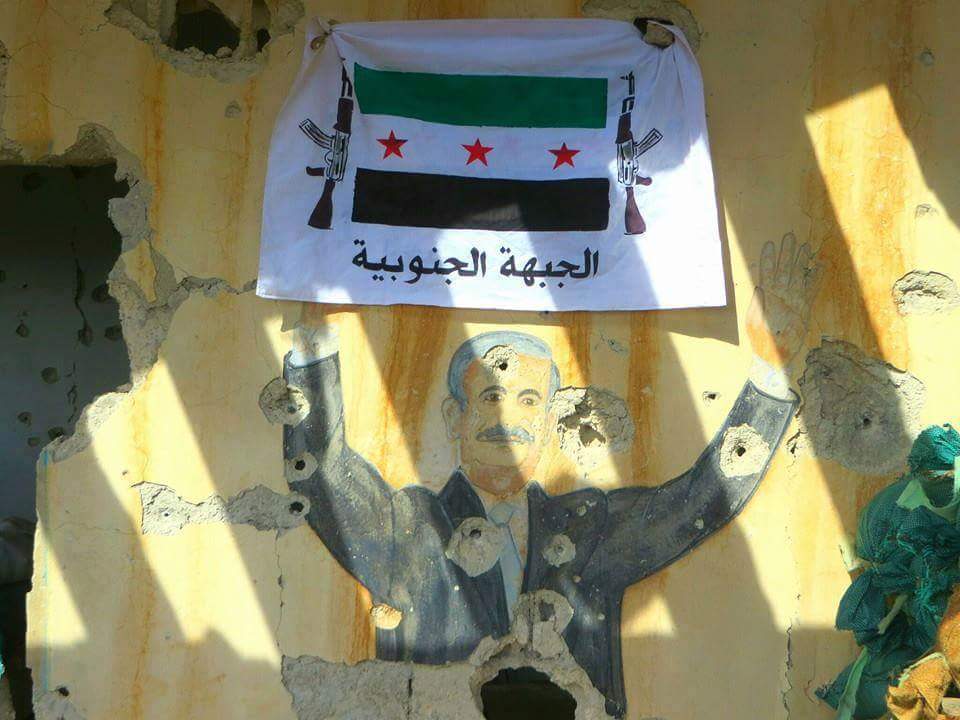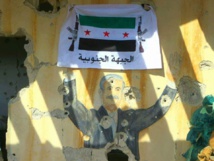"The 52nd Brigade base was fully liberated from the regime army," Major Essam al-Rayes said, adding at least 2,000 rebel fighters had taken part in the "short and quick" assault.
The base lies near a major highway running from Damascus to Syria's southern border with Jordan and is also near the frontier with neighbouring Sweida province, which is largely regime-controlled.
"This base was one of the main lines of defence for the regime forces. It was a nightmare, because they used it to shell all the areas to the east of the province," Rayes said.
The Southern Front was combing through the site for material left by regime troops, he said, adding the alliance would likely launch additional attacks from there in the near future.
Diaa al-Hariri, spokesman for Faylaq al-Awwal, one of the groups in the alliance, said the base was being used as a launching pad for the army's infantry.
The Syrian Observatory for Human Rights confirmed opposition groups had taken the base after clashes and intense shelling that killed 15 rebel fighters and 20 government forces.
- Latest regime setback -
Observatory chief Rami Abdel Rahman said rebel forces also seized two villages, including the Christian town of Al-Rakham, as regime troops withdrew to the nearby village of Al-Dara.
Rebels control a majority of Daraa province and its capital, Abdel Rahman said.
Syria's official news agency SANA did not report the capture of the base.
But earlier, citing a military source, it said the air force had struck the area, killing at least 40 "terrorists," who it accused neighbouring Jordan of backing.
The fall of the base is the latest in a string of defeats for the regime, which has lost territory to both rebel alliances in Syria's northwest and the Islamic State group in the country's centre.
It also follows defeats in Daraa, including in April the Nasib border post, its last crossing with Jordan.
Nonetheless, efforts towards a political solution to the crisis have faltered.
In Cairo, figures from the country's exiled opposition, as well as "tolerated" anti-regime figures from within Syria, agreed on a roadmap that ruled out any future role for President Bashar al-Assad.
The roadmap, distributed to journalists after a two-day meeting, also stressed the need for a negotiated solution under UN auspices starting with a ceasefire, prisoner release and the return of opposition figures from abroad.
- 230,000 dead -
Syria's conflict began in March 2011 with anti-government protests. After a regime crackdown, it spiralled into a civil war that has now killed more than 230,000 people, the Observatory said as it issued a new toll Tuesday.
The Britain-based group said nearly 70,000 civilians have died in the war, nearly 11,500 of them children.
More than 85,500 government forces -- soldiers and militiamen -- have been killed, along with over 41,000 rebels, Syrian jihadists and Kurdish fighters.
The monitor also documented the deaths of 31,247 foreign jihadists, and said another 3,191 people killed in the conflict have yet to be identified.
Many of the civilian deaths have come in government aerial attacks, particularly involving the use of "barrel bombs".
The weapon, criticised by rights groups as indiscriminate, has been used to devastating effect in Aleppo, where the Observatory said four members of one family were killed in such an attack Tuesday.
Syria's conflict has evolved into a complex, multi-front war that has drawn in jihadists including IS, which now rules a self-proclaimed "caliphate" in territory across Syria and Iraq.
The group on Tuesday claimed an attack against a government headquarters in Amriyat al-Fallujah, west of the capital Baghdad.
At least two people were killed in the assault by militants.
The attack came a year to the day since IS launched a sweeping offensive that overran much of Iraq's Sunni Arab heartland and seized Iraq's second city Mosul.
A US-led coalition striking the jihadists in both Syria and Iraq said it destroyed IS buildings, tactical units, and fighting positions near Mosul on Monday.
Meanwhile, the Pentagon said it was drawing up plans to expand the training of Iraqi forces and Sunni tribesmen in a step that could mean deploying more US troops in the country.
-----------------------------------------------------------------------------------------------------------------------
The base lies near a major highway running from Damascus to Syria's southern border with Jordan and is also near the frontier with neighbouring Sweida province, which is largely regime-controlled.
"This base was one of the main lines of defence for the regime forces. It was a nightmare, because they used it to shell all the areas to the east of the province," Rayes said.
The Southern Front was combing through the site for material left by regime troops, he said, adding the alliance would likely launch additional attacks from there in the near future.
Diaa al-Hariri, spokesman for Faylaq al-Awwal, one of the groups in the alliance, said the base was being used as a launching pad for the army's infantry.
The Syrian Observatory for Human Rights confirmed opposition groups had taken the base after clashes and intense shelling that killed 15 rebel fighters and 20 government forces.
- Latest regime setback -
Observatory chief Rami Abdel Rahman said rebel forces also seized two villages, including the Christian town of Al-Rakham, as regime troops withdrew to the nearby village of Al-Dara.
Rebels control a majority of Daraa province and its capital, Abdel Rahman said.
Syria's official news agency SANA did not report the capture of the base.
But earlier, citing a military source, it said the air force had struck the area, killing at least 40 "terrorists," who it accused neighbouring Jordan of backing.
The fall of the base is the latest in a string of defeats for the regime, which has lost territory to both rebel alliances in Syria's northwest and the Islamic State group in the country's centre.
It also follows defeats in Daraa, including in April the Nasib border post, its last crossing with Jordan.
Nonetheless, efforts towards a political solution to the crisis have faltered.
In Cairo, figures from the country's exiled opposition, as well as "tolerated" anti-regime figures from within Syria, agreed on a roadmap that ruled out any future role for President Bashar al-Assad.
The roadmap, distributed to journalists after a two-day meeting, also stressed the need for a negotiated solution under UN auspices starting with a ceasefire, prisoner release and the return of opposition figures from abroad.
- 230,000 dead -
Syria's conflict began in March 2011 with anti-government protests. After a regime crackdown, it spiralled into a civil war that has now killed more than 230,000 people, the Observatory said as it issued a new toll Tuesday.
The Britain-based group said nearly 70,000 civilians have died in the war, nearly 11,500 of them children.
More than 85,500 government forces -- soldiers and militiamen -- have been killed, along with over 41,000 rebels, Syrian jihadists and Kurdish fighters.
The monitor also documented the deaths of 31,247 foreign jihadists, and said another 3,191 people killed in the conflict have yet to be identified.
Many of the civilian deaths have come in government aerial attacks, particularly involving the use of "barrel bombs".
The weapon, criticised by rights groups as indiscriminate, has been used to devastating effect in Aleppo, where the Observatory said four members of one family were killed in such an attack Tuesday.
Syria's conflict has evolved into a complex, multi-front war that has drawn in jihadists including IS, which now rules a self-proclaimed "caliphate" in territory across Syria and Iraq.
The group on Tuesday claimed an attack against a government headquarters in Amriyat al-Fallujah, west of the capital Baghdad.
At least two people were killed in the assault by militants.
The attack came a year to the day since IS launched a sweeping offensive that overran much of Iraq's Sunni Arab heartland and seized Iraq's second city Mosul.
A US-led coalition striking the jihadists in both Syria and Iraq said it destroyed IS buildings, tactical units, and fighting positions near Mosul on Monday.
Meanwhile, the Pentagon said it was drawing up plans to expand the training of Iraqi forces and Sunni tribesmen in a step that could mean deploying more US troops in the country.
-----------------------------------------------------------------------------------------------------------------------









 Home
Home Politics
Politics











